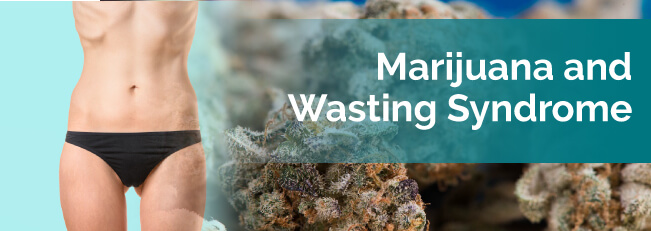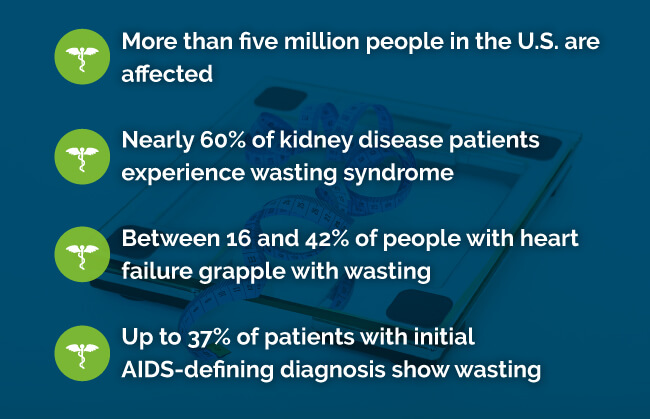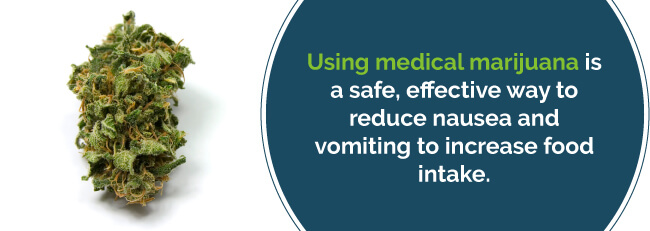
Wasting Syndrome occurs as a serious side effect of some underlying chronic illnesses. When you have this condition, you find that you aren’t excited about eating, and your body doesn’t seem to be holding onto calories and nutrients when you do. You feel as though your energy has been zapped and may lose a significant amount of weight.
There are many conventional medical treatments available to treat wasting syndrome — there’s also medical marijuana. Individuals have been using marijuana for the treatment of their ailments for centuries. There’s also some promising evidence it can help alleviate your wasting syndrome symptoms. In this article, we look in more detail at cannabis and wasting syndrome. You’ll find out more about your symptoms and the medical evidence behind the use of medical cannabis for wasting syndrome.
Wasting syndrome is a serious side effect of many debilitating diseases in which muscle and fat tissue “waste” away. Infections and conditions that cause wasting include cancer, HIV/AIDS, superior mesenteric artery syndrome, tuberculosis, chronic diarrhea, chronic obstructive lung disease, congestive heart failure and familial amyloid polyneuropathy. Some individuals develop wasting syndrome as a result of infection-related nutrient losses, an extremely reduced energy intake or a combination of both.

Wasting syndrome is characterized by the involuntary loss of more than more than 10% of your overall body weight. You also experience at least a month of fever, diarrhea and/or weakness. There are various factors that contribute to wasting syndrome, including:
If you develop infections with your chronic illness, it can increase the demand for your body’s energy needs. These infections can simultaneously interfere with your nutrients absorption and contribute to your fatigue. In turn, this can lead to a reduced appetite and low energy level that makes you less likely to cook for yourself or go out shopping for groceries. As this cycle continues, you eat less, which accelerates the wasting process. If you develop diarrhea or an infection, be sure to get treatment right away as they can interfere with proper absorption of nutrients.
The U.S. Centers for Disease Control and Prevention (CDC) recognized wasting syndrome in 1987 as an AIDS-defining condition. However, wasting syndrome is still not well understood. There’s no defined and agreed treatment plan if you have the syndrome. In fact, it used to be overlooked by doctors, as physicians focused their attention on the underlying illness, rather than treating the wasting.
Thankfully, this has changed. However, it’s clear that researchers need to conduct more studies.
It’s possible not to look malnourished if you have wasting syndrome. If you were overweight when the condition developed, you wouldn’t suddenly look emaciated. Your weight loss will be far more noticeable if you’re a naturally slim person. It’s not possible to make a diagnosis just by looking at someone.
The below symptoms must be present to diagnose wasting syndrome accurately:
You won’t have much of an appetite, and your muscles and body fat decrease. You’ll find you’re usually tired and lack the energy to do the activities you want or need to do.
If you’re suffering from underlying chronic illness, you often feel fatigued and have little appetite. Your immunity may be lower than usual, you could feel in low spirits or you could find you sometimes lack the energy to enjoy activities as much as you did before.
While the above may be so, you don’t have to suffer in silence. Marijuana could offer you the lifeline you need to live a more normal, happy and productive life.
Wasting syndrome isn’t extremely common, but it still affects a significant portion of the population:

It’s essential if you have HIV or another condition that potentially results in wasting that you avoid the loss of lean body mass. There are various treatments to manage wasting, such as medical marijuana. Other options include:
If none of these options sound appealing, consider medical marijuana. Weed is notorious for giving people “the munchies.” Many people develop a voracious appetite for some time after taking cannabis. Also, you avoid these side effects of some other medications, like steroids, when you take natural medical marijuana for wasting syndrome.
To manage wasting syndrome, patients must reduce nausea and vomiting to increase food intake. And according to strong scientific and anecdotal evidence, using medical marijuana is a safe, effective way to do so. AIDS activists have long urged the legalization of marijuana because of its ability to reduce nausea and stimulate the appetite in HIV/AIDS patients, combating severe weight loss.

Most marijuana states include wasting syndrome on their list of qualifying conditions, and doctors in every state can legally prescribe Marinol, a synthetic form of a substance found in marijuana, as an appetite stimulant in patients with wasting syndrome. Additionally, marijuana side effects are typically mild and are classified as “low risk,” with euphoric mood changes among the most frequent side effects.
A study of HIV/AIDS patients who consumed whole-plant cannabis along with dronabinol, found that participants gained more weight than those who took only a placebo. Another found that THC and marijuanause resulted in weight gain.
Published in the Journal of Acquired Immune Deficiency Syndromes in 2007, researchers from Columbia University found the smoking pot significantly improved appetite, decreased nausea, increased body weight and stimulated caloric intake in HIV-positive participants.
In their 1999 report, the Institute of Medicine (part of the National Academy of Sciences) and White House, commissioned that cannabis has a potential therapeutic value to control nausea and vomiting and stimulate appetite. The report concluded:
“Advances in cannabinoid science of the last 16 years have given rise to a wealth of new opportunities for the development of medically useful cannabinoid-based drugs. The accumulated data suggest a variety of indications, particularly for pain relief, nausea, and appetite stimulation. For patients, such as those with AIDS or undergoing chemotherapy, who suffer simultaneously from severe pain, nausea, and appetite loss, cannabinoid drugs might offer broad-spectrum relief not found in any other single medication.”
Opting to try medical marijuana is an easy decision when you’re looking for respite from your symptoms. Many U.S. states have legalized its recreational and medical use although pot remains illegal on a federal level.
You must have a condition that’s on your state’s list of qualifying medical marijuana conditions to qualify for medical marijuana for wasting syndrome. To date, more than 20 states have qualified wasting syndrome as an approved condition for the use of medical marijuana.
You can visit dispensaries and buy the products that suit your needs once you have a medical marijuana doctor’s recommendation and a medical marijuana card. There are many different strains available to purchase. Speaking with your doctor or an experienced budtender for advice is arguably the best way to find ones that may suit your own needs.
Marijuana is an effective appetite stimulant, as we mentioned earlier. Additionally, it treats the vomiting, nausea, depression and general malaise symptoms of wasting syndrome. To know which strain to choose for your treatment, you need to understand your symptoms and how cannabis can help. Each strain can treat a specific set of side effects. The three main types of marijuana are indica, sativa and hybrid strains.
Taking an indica strain tends to make you feel sedated to an extent. You feel a whole-body sensation and reduction in muscle tensions. Indica strains may be beneficial for treating conditions such as:
You feel energetic and clear-headed when you use a sativa strain. You feel this both in your body and your mind. Conditions and symptoms best treated with sativa flowers include:
Hybrid strains have characteristics of both types of cannabis. Taking these can work well if you’re in chronic pain, as both these types are suitable for treating this symptom. Combining sativa with an indica strain helps aid mental clarity and cuts down on any sedative effects. Adding indica to sativa strains helps lower the likelihood of a pure sativa giving you anxiety.
There’s a lot to learn when choosing a strain. Look at this list for some marijuana strains for wasting syndrome to consider:
Chronic illness zaps your energy and gets you down. If you’re tired of spending day after day in bed, these sativa strains could be what you need:

One of the main symptoms of wasting syndrome is a lack of appetite. Your nausea and vomiting may also fade away when you’re eating well. While there are many others strains that can spark your appetite, these three may help stimulate your hunger:
While some of the strains mentioned above work well for nausea and vomiting, the following cannabis strains can also help:
The following strains are thought to be helpful for eliminating symptoms of depression, allowing you to feel relaxed and calm:
You now know of some of the most effective strains of medical pot for wasting syndrome. But, have you considered how you might use them? The most common way to use weed in the U.S. is to smoke it. Smoking is arguably one of the fastest ways to take cannabis into your system; however, you run an increased risk of respiratory problems when you smoke.
So, what are the alternatives?
As you can see, there are many ways to take medical marijuana. You’re sure to find the one or ones that suit you by trying some of the suggestions above. Taking cannabis for wasting syndrome can significantly alleviate your symptoms. To recap, it can help:
Wasting syndrome and chronic illness can be debilitating, and marijuana no longer has the negative stigma it used to. In recent years, the medical community has woken up to its benefits, as more states are qualifying certain conditions, including wasting syndrome and cachexia, for the use of cannabis.
To find out if using medical marijuana for wasting syndrome is the right path for you, you need to find a marijuana doctor in your area. If you or someone close to you is looking for a way to gently and naturally relieve your wasting syndrome symptoms, while improving your general quality of life, search for a medical marijuana doctor or dispensary today to find out more.
Find A Doctor Find A Dispensary